CHECK FOR FUEL LEAKS (IN HIGH-PRESSURE AREAS)
CHECK FUEL RECEIVER GAUGE (AMOUNT OF FUEL)
CHECK WHETHER DTC OUTPUT RECURS (DTC P0093)
CHECK FREEZE FRAME DATA (INJECTION FEEDBACK VAL #1 TO #4)
READ VALUE USING INTELLIGENT TESTER (FUEL PRESS)
READ VALUE USING INTELLIGENT TESTER (INJECTION FEEDBACK VAL #1 TO #4)
PERFORM ENGINE SPEED ACCELERATION
CLEAN FUEL FILTER CASE AND REPLACE FUEL FILTER
PERFORM ACTIVE TEST USING INTELLIGENT TESTER (TEST THE FUEL LEAK)
PERFORM ACTIVE TEST USING INTELLIGENT TESTER (CONTROL THE CYLINDER #1 TO #4 FUEL CUT)
REPLACE FUEL INJECTOR OF MALFUNCTIONING CYLINDER
REPLACE FUEL INJECTORS OF ALL CYLINDERS
REGISTER INJECTOR COMPENSATION CODE AND PERFORM PILOT QUANTITY LEARNING
READ VALUE USING INTELLIGENT TESTER (ENGINE SPEED)
INSPECT ECM (FUEL PRESSURE SENSOR OUTPUT VOLTAGE)
INSPECT FUEL TEMPERATURE SENSOR (SENSOR OUTPUT)
CHECK FOR INTERMITTENT PROBLEMS
REPLACE CRANKSHAFT POSITION SENSOR
REPAIR OR REPLACE HARNESS OR CONNECTOR (ECM - FUEL PRESSURE SENSOR)
INSPECT ECM (FUEL PRESSURE SENSOR OUTPUT VOLTAGE)
REPLACE FUEL TEMPERATURE SENSOR
CHECK WHETHER DTC OUTPUT RECURS (DTC P0093)
DTC P0093 Fuel System Leak Detected - Large Leak |
DESCRIPTION
A fuel pressure sensor mounted on the common rail converts the fuel pressure inside the common rail into an electrical signal, and outputs it to the ECM. The ECM controls the supply pump in order to maintain the fuel pressure inside the common rail at a target pressure calculated by the ECM. Refer to System Description (Toyota Fortuner RM0000012WW024X.html).- HINT:
- If the drop in the internal fuel pressure is large when injecting fuel, the ECM interprets this as a fault and stores P0093.
- If P0093 is present, refer to the "Diagnostic Trouble Code (DTC) Table for Common Rail System" (Toyota Fortuner RM0000012WW024X.html).
| DTC Detection Drive Pattern | DTC Detection Condition | Trouble Area |
| After idling for 60 seconds, run engine at 2500 rpm for 30 seconds. Fully depress the accelerator pedal for 5 seconds, and then release it. (*A) Rev the engine to 3000 rpm and fully release the accelerator pedal immediately after the engine reaches 3000 rpm. (*B) Repeat procedures (*A) and (*B) 5 times. | Fuel leaks in high-pressure areas (1 trip detection logic) |
|
| DTC No. | Data List |
| P0093 |
|
- HINT:
- When DTC P0093 is set, check the internal fuel pressure of the common rail by entering the following menus on the intelligent tester: Powertrain / Engine and ECT / Data List / Fuel Press.
- Reference:
Engine Speed Fuel Pressure Idling Approximately 28000 to 40000 kPa 3000 rpm (No engine load) Approximately 30000 to 60000 kPa
MONITOR DESCRIPTION
- This DTC indicates that fuel leaks exist in high pressure areas in the common rail system. The ECM constantly monitors the internal fuel pressure of the common rail after the engine is started. The ECM sets this DTC if the drop in the internal fuel pressure is large when injecting fuel.
In the common rail system, high-pressure fuel is always supplied to the high-pressure areas including the supply pump, common rail, injectors and piping. The ECM adjusts the suction control valve opening angle to obtain the target internal fuel pressure.
If this DTC is set, the ECM enters fail-safe mode. Fail-safe mode suspends both fuel injection and supply pump operation, and then stops the engine. Before stopping the engine, the ECM permits the vehicle to be driven for 1 minute. Fail-safe mode continues until the ignition switch is turned OFF.
MONITOR STRATEGY
| Required sensors | Fuel pressure sensor |
| Frequency of operation | Continuous |
| Duration | 1 second |
| MIL operation | 1 driving cycle |
INSPECTION PROCEDURE
- NOTICE:
- Soon after starting the engine, visually check for fuel leaks in the fuel line.
- After replacing the ECM, the new ECM needs registration (Toyota Fortuner RM0000012XK04BX.html) and initialization (Toyota Fortuner RM000000TIN04NX.html).
- After replacing the fuel supply pump, the ECM needs initialization (Toyota Fortuner RM000000TIN04NX.html).
- After replacing a fuel injector, the ECM needs registration (Toyota Fortuner RM0000012XK04BX.html).
- HINT:
- Read freeze frame data using the intelligent tester. Freeze frame data records the engine condition when malfunctions are detected. When troubleshooting, freeze frame data can help determine if the vehicle was moving or stationary, if the engine was warmed up or not, and other data from the time the malfunction occurred.

- HINT:
- The following can be deduced from the above freeze frame data:
- The common rail fuel pressure dropped suddenly when the engine was being run at a moderate engine speed during engine warmup and DTC P0093 was stored at the point when data set 4 was recorded.
- Injection Feedback Val #3 is 5.0 mm3/st which is large (the normal value is between -3.0 and 3.0 mm3/st) and indicates that the injector of cylinder 3 may be malfunctioning.
- Actual cause: In this case, foreign matter in the fuel is stuck inside an injector causing the injector to malfunction temporarily.
In order to remove the foreign matter in the fuel (the major cause of the problem), the fuel filter case needs to be cleaned and the fuel filter needs to be replaced.

- HINT:
- *1: Fuel Press suddenly decreases for a moment, and then recovers. This can be seen clearly by comparing it to Target Common Rail Pressure.

- HINT:
- *2: Injection Feedback Val #3 is 5.0 mm3/st which is large (the normal value is between -3.0 and 3.0 mm3/st) and indicates that the injector of cylinder 3 may be malfunctioning.
| Data List | Value | Unit |
| Engine Speed | 1478 | rpm |
| Fuel Press | 8900 | kPa |
| Target Common Rail Pressure | 65320 | kPa |
| Injection Volume (Point A) | 51.26*1 | mm3/st |
| Injection Volume (Point A`) | 9.76 | mm3/st |
| Accel Position | 63.67 | % |
| Injection Feedback Val #1 | -1.1 | mm3/st |
| Injection Feedback Val #2 | -2.5 | mm3/st |
| Injection Feedback Val #3 | 5.0 | mm3/st |
| Injection Feedback Val #4 | -1.8 | mm3/st |
| MIL | ON | - |
| 1.CHECK FOR FUEL LEAKS (IN HIGH-PRESSURE AREAS) |
Before starting the engine, visually check for fuel leaks from the fuel supply pump, fuel injectors, common rail, and the fuel pipes in high-pressure areas.
- OK:
- No fuel leaks in high-pressure areas.
|
| ||||
| OK | |
| 2.CHECK FOR ANY OTHER DTC OUTPUT (PROCEDURE 2) (IN ADDITION TO DTC P0093 AND RECORD STORED DTC AND FREEZE FRAME DATA) |
Connect the intelligent tester to the DLC3.
Turn the ignition switch ON and turn the intelligent tester ON.
Enter the following menus: Powertrain / Engine and ECT / DTC.
Read the DTCs and freeze frame data.
- Result:
Display (DTC Output) Proceed to P0093 and "P0190, P0192 and/or P0193" C P0093 and "P0335 and/or P0339" B Except above A
|
| ||||
|
| ||||
| A | |
| 3.CHECK FUEL RECEIVER GAUGE (AMOUNT OF FUEL) |
Check if the fuel level is low.
- Result:
Result Proceed to The indicator (fuel warning light) is illuminated A The indicator (fuel warning light) is not illuminated B
|
| ||||
| A | |
| 4.ADD FUEL |
Add fuel.
| NEXT | |
| 5.CHECK WHETHER DTC OUTPUT RECURS (DTC P0093) |
Using the hand pump mounted on the fuel filter cap, bleed the air from the fuel system. Continue pumping until the pump resistance increases.
- NOTICE:
- Hand pump pumping speed: Max. 2 strokes/sec.
- The hand pump must be pushed with a full stroke during pumping.
- When the fuel pressure at the supply pump inlet port reaches a saturated pressure, the hand pump resistance increases.
- If pumping is interrupted during the air bleeding process, fuel in the fuel line may return to the fuel tank. Continue pumping until the hand pump resistance increases.
- If the hand pump resistance does not increase despite consecutively pumping 200 times or more, there may be a fuel leak between the fuel tank and fuel filter, the hand pump may be malfunctioning, or the vehicle may have run out of fuel.
- If a large amount of air remains inside the fuel system, the common rail pressure does not rise to the pressure range necessary for normal use, and the engine cannot be started.
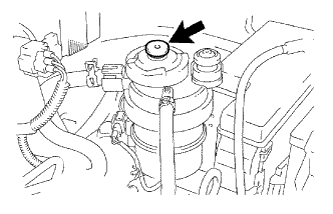 |
Start the engine.
- NOTICE:
- If a large amount of air remains inside the fuel system, the starter may need to be cranked for 10 seconds or more to start the engine.
- Do not crank the engine continuously for more than 20 seconds. The battery may be discharged.
- Use a fully-charged battery.
When the engine can be started, proceed to the next step.
If the engine cannot be started, bleed the air again using the hand pump until the hand pump resistance increases. Then start the engine.
Turn the ignition switch off.
Connect the intelligent tester to the DLC3.
Turn the ignition switch ON and turn the intelligent tester ON.
Clear DTCs (Toyota Fortuner RM0000012WY00RX.html).
Start the engine. (*A)
Enter the following menus: Powertrain / Engine and ECT / Active Test / Test the Fuel Leak. (*B)
Perform the following test 5 times with on/off intervals of 10 seconds: Active Test / Test the Fuel Leak. (*C)
Allow the engine to idle for 3 minutes or more after performing the Active Test for the fifth time. (*D)

Enter the following menus: Powertrain / Engine and ECT / DTC.
Read Current DTCs.
When no DTCs are output, the air bleeding is completed.
If any DTCs are output, proceed to the next step.
Repeat steps (*A) to (*D).
Clear DTCs (Toyota Fortuner RM0000012WY00RX.html).
Start the engine and warm it up.
Confirm that the shift lever is in neutral and securely apply the parking brake.
Fully depress the accelerator pedal for 5 seconds, and then release it. (*E)
Rev the engine to 3000 rpm and fully release the accelerator pedal immediately after the engine reaches 3000 rpm. (*F)
Repeat procedures (*E) and (*F) 5 times.
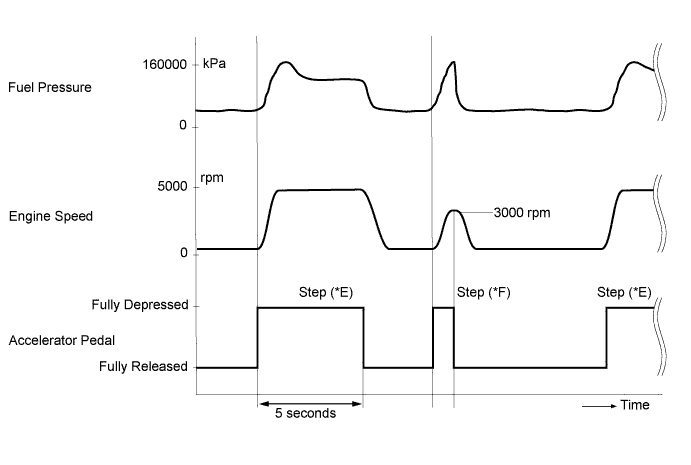
Enter the following menus: Powertrain / Engine and ECT / DTC.
Read Current DTCs.
- Result:
Display (DTC Output) Proceed to DTC output A DTC not output B
|
| ||||
| A | |
| 6.CHECK FREEZE FRAME DATA (INJECTION FEEDBACK VAL #1 TO #4) |
Read the value of Injection Feedback Val #1 to #4 in the Freeze Frame Data recorded in Procedure 2.
- Result:
Result Proceed to Injection Feedback Val for at least one cylinder is 5 mm3/st in at least 1 set of freeze frame data B Except above A
- HINT:
- When there is a problem with the operation of a fuel injector due to foreign matter in the inside of the fuel injector, etc., the fuel injection volume decreases. As a result, the ECM gives instructions to increase the fuel injection volume, which causes Injection Feedback Val to increase.
|
| ||||
| A | |
| 7.READ VALUE USING INTELLIGENT TESTER (FUEL PRESS) |
Connect the intelligent tester to the DLC3.
Turn the ignition switch to ON and turn the tester on.
Clear the DTCs (Toyota Fortuner RM0000012WY00RX.html).
Enter the following menus: Powertrain / Engine and ECT / Data List / Fuel Press.
Start the engine.
Read the value of Fuel Press while cranking and idling the engine.
Result Result Proceed to The engine cannot be started or the engine can be started but Fuel Press is less than 20000 kPa 2 seconds after the starter signal changes from OFF to ON. B Except above A
|
| ||||
| A | |
| 8.READ VALUE USING INTELLIGENT TESTER (INJECTION FEEDBACK VAL #1 TO #4) |
Connect the intelligent tester to the DLC3.
Turn the ignition switch to ON and turn the tester on.
Start the engine and warm it up.
Enter the following menus: Powertrain / Engine and ECT / Data List / Injection Feedback Val #1 to #4.
Read the values.
- Standard:
Tester Display Engine Condition* Normal Value Injection Feedback Val #1
Injection Feedback Val #2
Injection Feedback Val #3
Injection Feedback Val #4Idling -3.0 mm3/st to 3.0 mm3/st
- HINT:
- *: The A/C switch and all accessory switches should be off, the engine coolant temperature should be 70°C (158°F) or more and the engine should be idled for 1 minute or more.
Result Result Proceed to Injection Feedback Val for at least one cylinder is more than 3 mm3/st and engine vibration is abnormally large B Except above A - HINT:
- When there is a problem with the operation of a fuel injector due to foreign matter in the inside of fuel injector, etc., the fuel injection volume decreases. As a result, the ECM gives instructions to increase the fuel injection volume, which causes Injection Feedback Val to increase.
- The ECM controls the system so that the sum of Injection Feedback Val for all of the cylinders is approximately 0 mm3/st. Even if the value of Injection Feedback Val for a cylinder is less than -3.0 mm3/st (-3.0 mm3/st is the lowest normal value), as long as the value of Injection Feedback Val for each of the other cylinders is 3.0 mm3/st or less, the fuel injectors are not malfunctioning.
|
| ||||
| A | |
| 9.PERFORM ENGINE SPEED ACCELERATION |
Start the engine and drive the vehicle until the engine coolant temperature reaches 60°C (140°F) or higher.
Stop the vehicle and allow the engine to idle.
While checking the tachometer, fully depress the accelerator pedal for 5 seconds, and then release it.*1
Repeat procedure *1 5 times.
Result Result Proceed to No problems such as sluggishness or variations in the tachometer reading A Except above B
|
| ||||
| A | |
| 10.CLEAN FUEL FILTER CASE AND REPLACE FUEL FILTER |
Clean the fuel filter case and replace the fuel filter.
- HINT:
- Be sure to clean the inside of the fuel filter case as the fuel injectors may not operate properly if the fuel filter is installed with foreign matter remaining inside the fuel filter case.
| NEXT | |
| 11.BLEED AIR FROM FUEL SYSTEM |
Bleed the air from the fuel system (Toyota Fortuner RM0000014FK006X_01_0002.html).
| NEXT | |
| 12.PERFORM ACTIVE TEST USING INTELLIGENT TESTER (TEST THE FUEL LEAK) |
Connect the intelligent tester to the DLC3.
Turn the ignition switch to ON and turn the tester ON.
Enter the following menus: Powertrain / Engine and ECT / Active Test / Test the Fuel Leak / Data List / Fuel Press, Target Common Rail Pressure, and Target Pump SCV Current.
Take a snapshot with the intelligent tester during the Active Test.
- HINT:
- Detailed graphs can be displayed by transferring the stored snapshot from the tester to a PC (personal computer) with Intelligent Viewer installed.
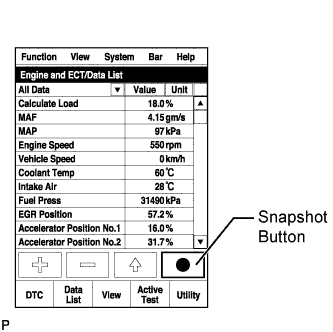 |
Measure the difference between the target fuel pressure (Target Common Rail Pressure) and the actual fuel pressure (Fuel Press) when the "Test the Fuel Leak" Active Test is performed.
- HINT:
- In order to obtain an exact measurement, perform the Active Test 5 times and measure the difference once each time the Active Test is performed.

- OK:
- The difference between the target fuel pressure and the actual fuel pressure 2 seconds after the Active Test starts is less than 10000 kPa.
- HINT:
- "Target Common Rail Pressure" is the target fuel pressure controlled by the ECM.
- "Fuel Press" is the actual fuel pressure.
Result Result Proceed to The difference between the target fuel pressure and the actual fuel pressure 2 seconds after the Active Test starts is less than 10000 kPa. A Except above B
|
| ||||
| A | |
| 13.PERFORM ACTIVE TEST USING INTELLIGENT TESTER (CONTROL THE CYLINDER #1 TO #4 FUEL CUT) |
- HINT:
- Use this Active Test to determine the malfunctioning cylinder.
Connect the intelligent tester to the DLC3.
Start the engine and turn the tester on.
Enter the following menus: Powertrain / Engine and ECT / Active Test / Control the Cylinder #1 to #4 Fuel Cut.
- HINT:
- If the engine idle speed does not change when a fuel injector is disabled, the cylinder being tested is malfunctioning. Record any malfunctioning cylinders.
- If the cylinder being tested is normal, there will be a significant change in idle speed when the fuel injection is stopped for that cylinder.
| NEXT | |
| 14.REPLACE FUEL INJECTOR OF MALFUNCTIONING CYLINDER |
Replace the fuel injector of the malfunctioning cylinder (Toyota Fortuner RM000002SY101UX.html).
|
| ||||
| 15.REPLACE FUEL INJECTORS OF ALL CYLINDERS |
Replace the fuel injectors (Toyota Fortuner RM000002SY101UX.html).
| NEXT | |
| 16.BLEED AIR FROM FUEL SYSTEM |
Bleed the air from the fuel system (Toyota Fortuner RM0000014FK006X_01_0002.html).
| NEXT | |
| 17.REGISTER INJECTOR COMPENSATION CODE AND PERFORM PILOT QUANTITY LEARNING |
Register the injector compensation code (Toyota Fortuner RM0000012XK04BX_02_0003.html).
Perform the fuel injector pilot quantity learning (Toyota Fortuner RM0000012XK04BX_02_0009.html).
|
| ||||
| 18.READ VALUE USING INTELLIGENT TESTER (ENGINE SPEED) |
Connect the intelligent tester to the DLC3.
Turn the ignition switch to ON and turn the tester ON.
Enter the following menus: Powertrain / Engine and ECT / Data List / Engine Speed.
Read the value while cranking and idling the engine.
- Standard:
Tester Display Engine Condition Specified Condition Engine Speed Cranking 50 to 400 rpm Idling with warm engine 700 to 800 rpm
- HINT:
- The value should be the same as the actual engine speed and displayed with no interruption on the tester.
|
| ||||
| OK | |
| 19.INSPECT ECM (FUEL PRESSURE SENSOR OUTPUT VOLTAGE) |
Connect the positive (+) probe of an oscilloscope to the fuel pressure sensor input terminal of the ECM connector and the negative (-) probe to the body ground.
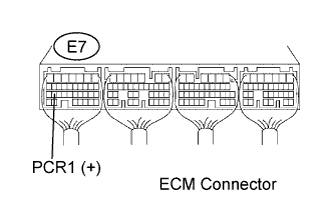 |
Turn the ignition switch to ON.
Check for any noise in the waveform when vibration is applied to the wire harness and connectors between the fuel pressure sensor and ECM.


- Standard voltage:
Tester Connection Condition Specified Condition E7-26 (PCR1) - Body ground Vibration is applied to the wire harness and connectors No noise in the waveform
- Result:
Result Proceed to MIL comes on or noise present in the waveform B Except above A
|
| ||||
| A | |
| 20.INSPECT FUEL TEMPERATURE SENSOR (SENSOR OUTPUT) |
Connect the intelligent tester to the DLC3.
Turn the ignition switch to ON and turn the tester ON.
Enter the following menus: Powertrain / Engine and ECT / Data List / Fuel Temperature.
Read the value.
- OK:
- The value is almost the same as the actual fuel temperature.
- HINT:
- When the engine is stopped and left overnight, the fuel temperature becomes the same as the atmospheric temperature.
- If there is a problem with the fuel temperature sensor, and a fuel temperature value lower than the actual fuel temperature is indicated, P0093 may be detected.
|
| ||||
| OK | |
| 21.CHECK FOR INTERMITTENT PROBLEMS |
Check for intermittent problems (Toyota Fortuner RM0000012X400RX.html).
|
| ||||
| 22.REPLACE CRANKSHAFT POSITION SENSOR |
Replace the crankshaft position sensor.
- HINT:
- Before replacing the crankshaft position sensor, perform a wire harness inspection and if there are any problems with the wire harness, repair or replace it.
|
| ||||
| 23.REPAIR OR REPLACE HARNESS OR CONNECTOR (ECM - FUEL PRESSURE SENSOR) |
Repair or replace the harness or connector.
| NEXT | |
| 24.INSPECT ECM (FUEL PRESSURE SENSOR OUTPUT VOLTAGE) |
Connect the positive (+) probe of an oscilloscope to the fuel pressure sensor input terminal of the ECM connector and the negative (-) probe to the body ground.
 |
Turn the ignition switch to ON.
Check for any noise in the waveform when vibration is applied to the wire harness and connectors between the fuel pressure sensor and ECM.
- Standard voltage:
Tester Connection Condition Specified Condition E7-26 (PCR1) - Body ground Vibration is applied to the wire harness and connectors No noise in the waveform
- Result:
Result Proceed to MIL comes on or noise present in the waveform A Except above B
|
| ||||
| A | |
| 25.REPLACE COMMON RAIL ASSEMBLY |
Replace the common rail assembly (Toyota Fortuner RM000002SY501VX.html).
- HINT:
- Before replacing the common rail assembly, perform a wire harness inspection and if there are any problems with the wire harness, repair or replace it.
| NEXT | |
| 26.BLEED AIR FROM FUEL SYSTEM |
Bleed the air from the fuel system (Toyota Fortuner RM0000014FK006X_01_0002.html).
|
| ||||
| 27.REPLACE FUEL TEMPERATURE SENSOR |
Replace the fuel temperature sensor.
- HINT:
- Before replacing the fuel temperature sensor, perform a wire harness inspection and if there are any problems with the wire harness, repair or replace it.
| NEXT | |
| 28.CHECK WHETHER DTC OUTPUT RECURS (DTC P0093) |
Connect the intelligent tester to the DLC3.
Turn the ignition switch to ON and turn the tester ON.
Enter the following menus: Powertrain / Engine and ECT / DTC.
Clear DTCs (Toyota Fortuner RM0000012WY00RX.html).
Start the engine.
Warm up the engine (engine coolant temperature is 70°C (158°F) or higher).
Confirm that the shift lever is in neutral and securely apply the parking brake.
Fully depress the accelerator pedal for 5 seconds, and then release it. (*A)
Rev the engine to 3000 rpm and fully release the accelerator pedal immediately after the engine reaches 3000 rpm. (*B)
Repeat procedures (*A) and (*B) 5 times.
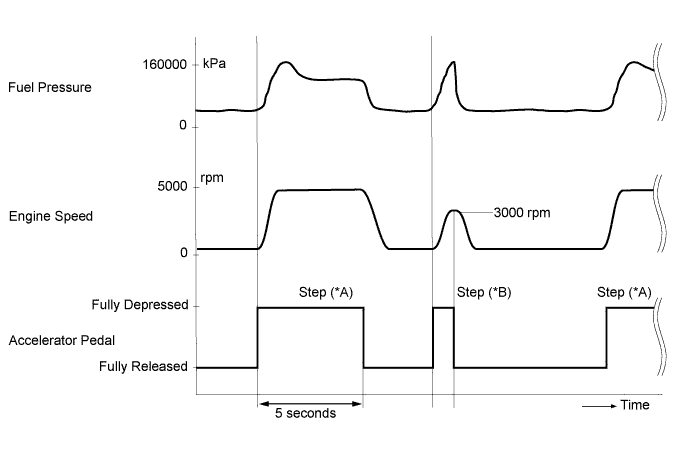
Enter the following menus: Powertrain / Engine and ECT / DTC.
Read the DTCs.
- OK:
- No DTCs are output.
| NEXT | ||
| ||